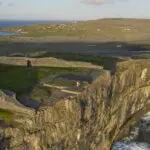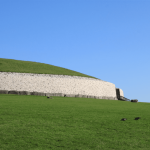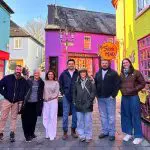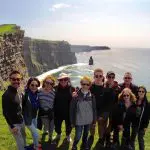In 2018, Lonely Planet declared islands to be the year’s most popular travel trend. One year on and it looks as though visiting islands will be equally popular in 2019. If you fancy island hopping, there is no better place than the islands off the coast of Ireland.
But, with eighty islands to choose between, it’s going to be time-consuming to look through them all. To save you some time, we’ve compiled a list of some of the best ones — some of which we visit on our small-group tours of Ireland.
Grab a cup of tea or a glass of wine (depending on the time of day!), find a comfy chair, and check out some of the best Irish islands to visit. If you have any questions for us in the meantime, please get in touch!
Rathlin Island, County Antrim
The most northern island, this is where Robert the Bruce took refuge from Edward 1st (think Mel Gibson and Braveheart) and saw the infamous spider. If you have a minute Google the full story, but basically he was hiding in a cave watching a spider try to swing to a nearby rock. The spider had failed six times. Bruce said to himself that if the spider made it the next time, he’d go back and try again to defeat the English. The spider made it and so did Robert the Bruce. So, as they say, ‘if at first you don’t succeed try, try and try again’.
For an alternative walk through fascinating history, consider following St. Patrick’s footsteps through Ireland!
Rathlin is now probably better known for its wildlife and the West Light Seabird Centre – a great place to start your trip to the island. The sheer number of birds is fantastic, and you’ll see puffins, guillemots, and kittiwakes – between late April and July is the best time to see puffins. There is also a cliff-top walking trail, where you can check out the seals below. After your walk, why not stop at McCuaig’s Bar for a Guinness and some classic Northern Irish cuisine?
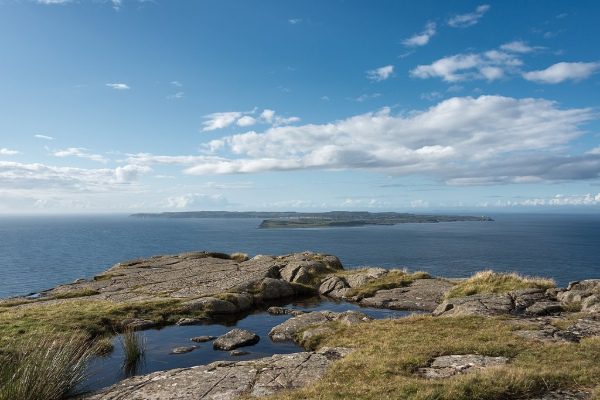
Inishmore (Inis Mór), Galway Bay
This is the largest and most developed of the Aran Islands. On your arrival, you’ll be greeted by rare wildflowers, like orchids and violets, growing out of the rocks. The island is dotted with circular forts, medieval churches, and early Christian remains. It’s one of the most famous historic sites in Europe, with the most Instagram-worthy spot being at the semi-circular stone fort sitting on top of the hill overlooking a hundred-meter drop into the sea.
While you’re on the island, you should try and find ‘the Wormhole’. It’s well hidden but well worth the effort to look for. There aren’t many signposts, but if you ask a local they’ll be able to point you in the right direction. The Wormhole is a natural rectangular-shaped pool that fills up and empties with the tides. You can even jump off the cliff into it if you feel the need (I’d save that for the summer!). If you’re heading to the Wormhole make sure you’re wearing a good pair of shoes, as there are lots of craggy rocks.
If you want to stay the night, you’ll not be bored with the nightly music and dancing at the three pubs on the island.
Just two of our tours that visit Inishmore are the Ultimate Ireland 10-Day Tour and the Ireland to Island 7-Day Tour.
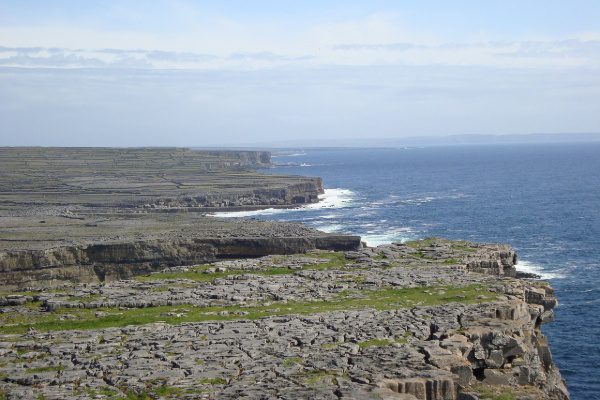
Clare Island, Clew Bay, Co. Mayo
Lying three miles off the coast of Mayo, this is the birthplace of the Pirate Queen Grace O’Malley who ruled the waters of Clew and Galway Bay.
Famous for its hills and woodlands, you’ll also be able to partake in walking activities, yoga, and equestrian adventures at the Macalla Horse Farm.
There are a fair few buildings to see on the island, including the Church of the Sacred Heart built in 1860, Granuaile’s Castle built in the 16th century to control the waters of Clew Bay and subsequently converted into police barracks in the 1820s, and the famous lighthouse sitting high on the rocks which has now been converted into luxury accommodation.
Events on the island include the Singles Adventure Weekend, the Feile Ceoil Festival, and the Clare Island Regatta.
Check out our picks for 10 Irish attractions off the beaten path to inspire even more non-touristy adventures!
Skellig Michael, County Kerry
Take a boat from the mainland and climb the five hundred steps up the old stone stairway to the top of this famous island. You may well recognize it, as it was home to the final scene in the 2015 Star Wars movie, The Force Awakens.
The island towers 218 meters above sea level and is topped by a monastic settlement where monks lived and prayed in the 6th century. The stone huts of the settlement look like beehives.
A multitude of wild birds can be photographed here, including puffins, gannets, and herring gulls. 23,000 pairs of gannets nest on the island, making it the second-largest gannet colony in the world. Get your camera ready!
If you’re looking for even more outstanding attractions to visit on your trip, we think you’ll love reading our blog What are the Top Five Places to Visit in Ireland?
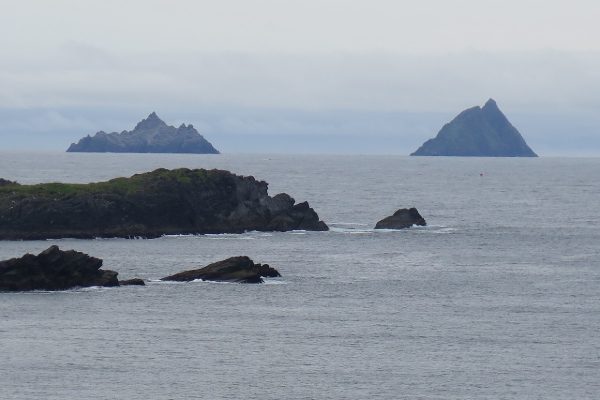
Cape Clear Island, County Cork
With a population of just 100 people, Cape Clear is accessible by ferry and there’s plenty of ancient archaeology and wildlife to be seen. Some of the island’s buildings include the ruins of a 12th-century church and the ruins of the 14th-century O’Driscoll Castle. Check out the lighthouse that sits on top of Fastnet Rock, named after the famous race.
While you’re there take some time to visit the heritage centre or the goat farm, where you can see goat milking and buy homemade cheese and ice cream.
Has this whetted your appetite for a walk on the wild side? Read through our recommendations for the best wild places in Ireland for even more travel inspiration.
Valentia Island, County Kerry
Visit Cromwell Point to see the Valentia Lighthouse, one of the twelve great lighthouses of Ireland. With 350 million years of history here, you’ll also see the fossilized footprints of a tetrapod and the birthplace of the Transatlantic Telegraph Cable and global communications.
There are plenty of places to stay overnight, ranging from camping to B&Bs, self-catering, and a hotel. Throughout the summer months, the island holds food and music festivals as well as sporting events.
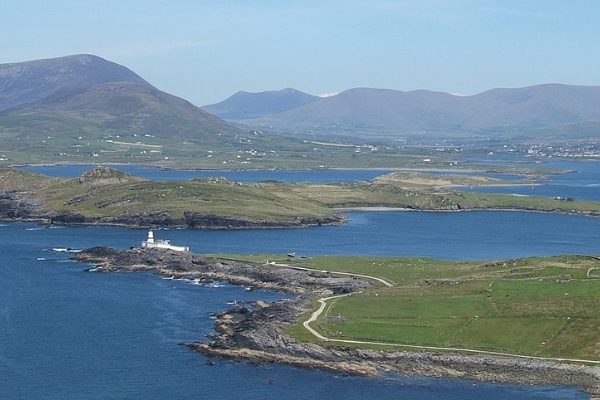
Sketrick Island, Newtownards
Situated in Stranford Lough, the largest sea lough in the British Isles, from this island, you can see basking seals and wading birds including herons and white egrets.
You can walk, drive or cycle over the permanent bridge, then take some time to wander the ruins of Castle Sketrick, which was built in the 15th century. It would have originally been four stories high with a boat bay and underground passages.
Daft Eddy’s on the island is the perfect spot to stop for breakfast, lunch, or just a famous Maud’s ice cream on a sunny day.
For more fun-filled days north of the border, read our choices for the best outdoor activities in Northern Ireland.
Great Blasket Island, County Kerry
Three miles from the westerly tip of the Dingle Peninsula, this island was inhabited until 1953 when, suffering from the famine, the last twenty-two inhabitants moved to the mainland. Over the past few years, a few of the houses on the island have been restored allowing you to stay overnight.
In her autobiography Peig, Peig Sayers documents life on the island after she married a fisherman and moved there.
The island is a haven for wildlife and has some good walking tracks and loads of opportunities for amazing photos. Bring a good pair of walking shoes!
While you’re in Kerry, don’t miss the opportunity to travel on the world-famous Ring of Kerry! Our Ultimate Guide to the Ring of Kerry is the perfect introduction to this iconic experience.
Dursey Island, County Cork
The only island accessible by cable car – in fact, the only cable car in Ireland – Dursey Island has a few residents but there are no shops there. So, bring your own food and water if you’re visiting.
From the island, you can often see whales, dolphins, and a variety of seabirds.
Coney Island, Lough Neagh, County Armagh
A must-visit for any Van Morrison fan, Coney Island is only accessible by boat or canoe. There are nine acres of thickly wooded forest, with a few buildings, a holy well, and a stone tower bringing with them evidence of human occupation dating back some eight thousand years. St Patrick was said to have used Coney Island as a place of retreat in the 5th century. The 19th-century cottage on the island was recently refurbished by the National Trust and is available for rent. Before you leave, don’t forget to make a wish on the wishing stone.
Garnish Island, County Cork
Bought by a Belfast man in the 1900s for his wife, Garnish Island is famous for its gardens and seal colony. The elaborate gardens were intended as a forerunner to a mansion, which was sadly never built.
Both George William Russell and George Bernard Shaw visited the island for inspiration. The island was bequeathed to the Irish people in 1953 and has been open to the public ever since. You can catch the ferry from Glencariff to Garnish Island – the ferry trip includes a visit to Seal Island and its very tame colony of c.250 seals.
Tory Island, County Donegal
Writers and artists love Tory Island for its light and scenery. Tory Island artists have paintings in many major galleries in the UK and Europe, and many of their works can be seen in the gallery on the island.
As well as art, the island has a love for music and singing. It holds Céilís every night and has some excellent singers with a range of traditional Irish songs and ballads.
There is so much to see that it’s worth staying the night in one of the many B&Bs.
Are you wondering how best to travel around and see these amazing sites and more? Our Ultimate Guide to Getting Around Ireland is filled with handy local tips and insights to make your holiday as seamless as possible.
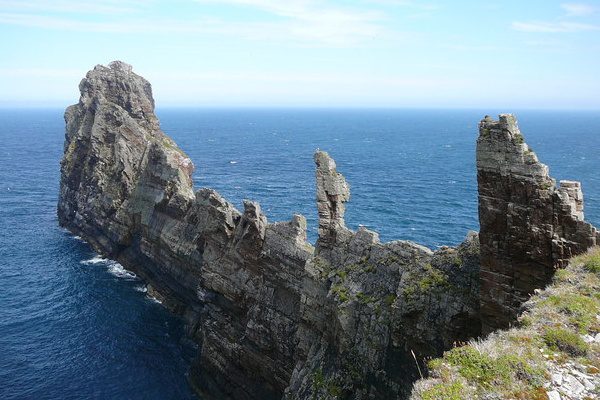
Great Saltee, County Wexford
Although the Neale family has privately owned the island since 1943, day-trippers are still allowed to visit. You’ll know if the owners are home because their flag will be flying! With a ratio of 1:100 seabirds to humans, it’s an ornithologist and bird watcher’s dream. Bring your camera and photograph gannets, gulls, puffins, and Manx shearwaters. There are also caves to explore, and you can learn to fish on board the Kilmore Quay Angling Fleet.
There are no facilities on the island, so bring your own food and water.
Sherkin Island, County Cork
Take the ten-minute ferry ride over to Sherkin from the fishing village of Baltimore. With a population of approximately a hundred, Sherkin has a school, hotel, B&B, and two pubs. There’s lots of wildlife to see including porpoises, dolphins, and whales.
The Sherkin Regatta is the busiest day of the year and includes the Sherkin fair with loads of stuff for the kids, as well as music and food stalls.
For a deeper dive into Irish cuisine, check out our Gastronomic Guide to Ireland when you’ve finished here.
Spike Island, County Cork
Built 200 years ago, Fort Michel is situated on a 103-acre-old monastic site. Because of its location within the harbor, it was used as a prison and for defense. In 1850 there were 2,000 convicts on Spike Island, but by 1883 the prisoners had all been transferred to the mainland. The site opened again between 1985 and 2004 to hold young offenders who mainly stole cars.
A few years ago, it was developed into a huge visitor center and tourist attraction, and now has more than 10,000 visitors per year. Highlights include the punishment block and 1980s cells, including an exhibition of the 1985 Spike Island riot.
In 2017 at The World Traveller Awards, Spike Island was named ‘Europe’s Leading Tourist Attraction’.
You can get there by taking the ferry from Kennedy Pier, Cobh.
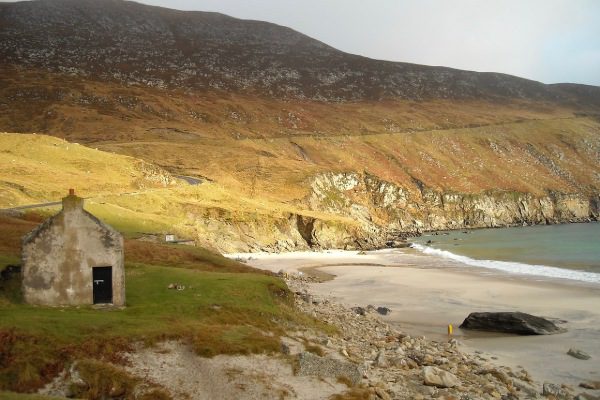
Achill Island, County Mayo
With a population of 2,500, this is the largest of the Irish Isles and is accessible only by a bridge.
There’s a long tradition of pipe bands on the island and it’s home to one of Ireland’s oldest traditional music summer schools, Scoil Acla. Here you can learn a range of traditional instruments like the harp, flute or tin whistle. If you love a parade, head to Achill on St Patrick’s Day when the parade lasts all day! The school also hosts writer’s workshops, art exhibitions, and drama classes.
There’s loads to do on Achill with plenty of places to stay, plus restaurants and Irish pubs. You’ll often come across the musicians from Scoil Acla in one of the pubs.
If you’re into abandoned buildings, there are 80 stone farmhouses on Achill called the Deserted Village, which was abandoned in 1845 because of the Irish Famine.
To find out more about the amazing islands you can visit off the coast of Northern Ireland and the Republic of Ireland, contact Overland Ireland today. We run a fantastic range of small-group Ireland tours showing you the best the Emerald Isle – and its little islands – has to offer.



